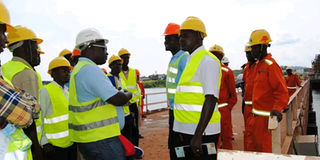What to expect at international construction exhibition

The expo will bring together all industry stakeholders to share knowledge and forge a way forward. Photos / Courtesy.
What you need to know:
- Trade shows tend to exhibit higher rates of return than direct marketing and advertising, which are primarily successful in cases where the industry is small and organised.
The face of East African construction industry is changing fast as projects get bigger and more complex. According to recent reports, this is due to rapid urbanisation, economic growth, a rising middle class and regional integration that make for the ever-increasing demand in Africa’s construction industry. As big infrastructure projects get underway on the continent, this development leaves industry stakeholders considering ways to branch out and expand their trades.
Trade fairs and conferences play a major part in showcasing the latest technologies and construction trends. Uganda has witnessed an impressive real estate boom, which has changed its skyline and landscape. Uganda is expected to register a compound annual growth of 6.4 percent with the construction industry contributing more than over 12 percent of Uganda’s gross domestic product (GDP).
Despite the recent upsurge in inflation, the industry has maintained a steady growth and development which is great for both local and international investors.
The industry has support from the government which has allocated 16.2 percent of its budget to road infrastructure which is the largest allocation of any sector. This is in effort to improve infrastructure development through modern railway lines, world-class highways and standard residential projects, high rise buildings and many more. The Ugandan construction market has a variety of growth opportunities buoyed by the infrastructure gap, population and economic growth and supportive government policies.
Uganda Buildcon 2022 trade fair which is scheduled to be held from August 11 to 13 at UMA Show Ground, Kampala, is one of the efforts aimed at facilitating and bridging the gap in demand and supply in the construction industry.
The trade fair is supported by Uganda National Association of Building and Civil Engineering Contractors (UNABCEC), Ministry of Land, Housing and Urban Development and Uganda Manufacturers Association. Uganda Buildcon International Expo 2022 will showcase innovations in the construction sector focusing on building materials, heavy equipment, machinery, tools, engineering, architecture, interior designs, commercial vehicles, among others from within Uganda and other countries. It will also provide a platform for networking, investment and exchange of ideas and information. Participants will present and curate a unique and memorable experience for their customers.

Why you should be there
● Trade shows are an effective non-mass media tool to market your company and its products, new and existing. The African Global Competitiveness Initiative identifies trade shows as the most accessible best practice for connecting to new markets. Trade shows tend to exhibit higher rates of return than direct marketing and advertising, which are primarily successful in cases where the industry is small, organised and scarce in supply, or when the character of the consumer market is well understood. Think of it this way: one day spent at an exhibition provides access to more clients from more places than one could ever visit during a typical workday.
● The government of Uganda has allocated 16.2 percent of its budget to road infrastructure, which is the largest allocation of any sector.
● Access to get Uganda 300,000 housing projects which are needed every year.
● Public-private partnership for construction material factories in Uganda.
● A cost-effective way to develop your business potential. The Ugandan construction market brings promising growth opportunities with the infrastructure gap, population and economic growth.
● Platform to penetrate in East Africa Region. Uganda and the East African region are growing steadily in both population and GDP.




